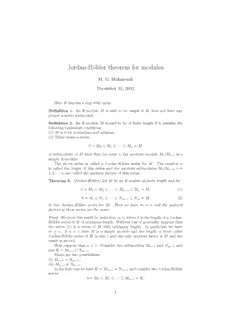
Jordan-Hölder theorem for modules PDF
Preview Jordan-Hölder theorem for modules
Jordan-Ho¨lder theorem for modules M. G. Mahmoudi December 11, 2012 Here R denotes a ring with unity. Definition 1. An R-module M is said to be simple if M does not have any proper nonzero submodule. Definition 2. An R-module M is said to be of finite length if it satisfies the following equivalent conditions: (1) M is both noetherian and artinian. (2) There exists a series 0=M ⊂M ⊂···⊂M =M 0 1 n of submodules of M such that for every i, the quotient module M /M is a i i−1 simple R-module. The above series is called a Jordan-H¨older series for M. The number n is called the length of this series and the quotient submodules M /M , i = i i−1 1,2,···n, are called the quotient factors of this series. Theorem 3. (Jordan-H¨older) Let M be an R-module of finite length and let 0=M ⊂M ⊂···⊂M ⊂M =M, (1) 0 1 n−1 n 0=N ⊂N ⊂···⊂N ⊂N =M (2) 0 1 m−1 m be two Jordan-Ho¨lder series for M. Then we have m = n and the quotient factors of these series are the same. Proof. Weprovetheresultbyinductiononk,wherek isthelengthofaJordan- H¨older series of M of minimum length. Without loss of generality suppose that the series (1) is a series of M with minimum length. In particular we have m ≥ n. If n = 1 then M is a simple module and the length of every other Jordan-H¨older series of M is also 1 and the only quotient factor is M and the result is proved. Now suppose that n > 1. Consider two submodules M and N and n−1 m−1 put K =M ∩N . n−1 m−1 There are two possibilities: (i) M =N . n−1 m−1 (ii) M (cid:54)=N . n−1 m−1 InthefirstcasewehaveK =M =N andconsidertwoJordan-H¨older n−1 m−1 series: 0=M ⊂M ⊂···⊂M =K, 0 1 n−1 1 0=N ⊂N ⊂···⊂N =K. 0 1 m−1 The above series shows that K has a Jordan-Holder series of length ≤n−1, so the induction hypothesis implies that n−1 = m−1 and the quotient factors of above series are the same. Consequently the Jordan-H¨older series in (1) and (2) have the same length and the same quotient factors. In the second case, we have K (cid:40) M and K (cid:40) N . As M (cid:54)= n−1 m−1 n−1 N and M and N are maximal in M we obtain M +N =M. m−1 n−1 m−1 n−1 m−1 Consequently we have: M /K =M /(M ∩N )(cid:39)(M +N )/N =M/N . n−1 n−1 n−1 m−1 n−1 m−1 m−1 m−1 So M /K (cid:39)M/N , (3) n−1 m−1 similarly we have N /K (cid:39)M/M . (4) m−1 n−1 InparticulartwoquotientmodulesM /K andN /K aresimplemodules. n−1 m−1 As M is both artinian and notherian, K is as well. In particular K has a Jordan-H¨older series as follows: 0=K ⊂K ⊂···⊂K =K. 0 1 r We therefore obtain two new Jordan-H¨older series for M: 0=K ⊂K ⊂···⊂K =K ⊂M ⊂M =M (5) 0 1 r n−1 n 0=K ⊂K ⊂···⊂K =K ⊂N ⊂N =M (6) 0 1 r m−1 m By (1), M has a Jordan-H¨older series of length ≤n−1 so we can apply the n−1 induction hypothesis for M , so all Jordan-H¨older series of M are of the n−1 n−1 same length. By (5), M has a Jordan-H¨older series of length r+1 and by n−1 (1), M has a Jordan-H¨older series of length n−1 so we have r+1=n−1 n−1 and two Jordan-H¨older series 0=K ⊂K ⊂···⊂K =K ⊂M 0 1 r n−1 and 0=M ⊂M ⊂···⊂M 0 1 n−1 have the same quotient factors. Hence the length and the quotient factors of two series (1) and (5) are the same. Also by (6), N has a series of length m−1 r+1 = n−1. By induction the length and the quotient factors of the below Jordan-H¨older series of N are the same: m−1 0=K ⊂K ⊂···⊂K =K ⊂N 0 1 r m−1 and 0=N ⊂N ⊂···⊂N . 0 1 m−1 Consequently the length and the quotient factors of two series (2) and (6) are the same. By (3) and (4), the length and the quotient factors of two series (5) and (6) are the same. So the lengths and the quotient factors of two series (1) and (2) are the same. M. G. Mahmoudi, DepartmentofMathematicalSciences,SharifUniversityofTechnology,P.O.Box 11155-9415, Tehran, Iran. E-mail address: [email protected] 2
